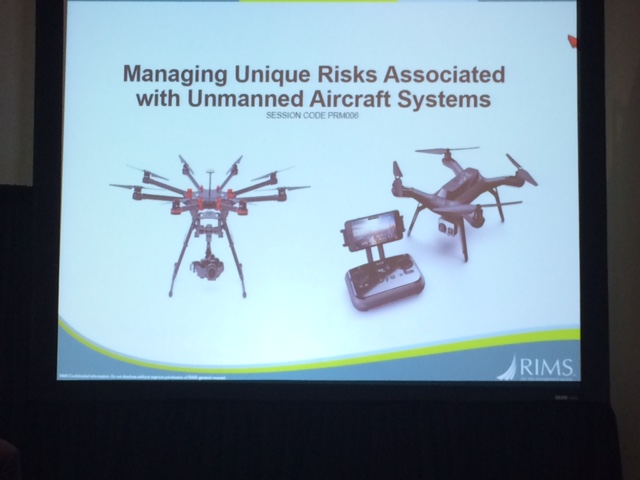Managing Unique Risks Posed by Unmanned Aircraft Systems
The speakers in this RIMS 2016 session were:
- James Van Meter, Aviation Practice Leader, Allianz Global Corporate & Specialty
- Mark Lauderbaugh, Director, Risk Management, Crown Castle International Corp.
With over 4,000 FAA approved small unmanned aircraft systems used in commercial operations and an average of 50 new ones per week, the FAA estimates that by 2020 there will be about 30,000 unmanned aircraft systems (UAS) used for business purposes. In addition, there are over 400,000 registered hobby users. Integration of UAS is a top priority and the FAA is finalizing rules for commercial UAS operations. Companies and their clients can be exposed to potential liability from UAS but insurance innovation can protect them.
There are several types of UAS from fixed-wing and rotor-wing to multi-copters, most have automated take-off and landing sequences and many have sophisticated cameras and sensors which are often the most valuable components.
The FAA classifies UAS in 3 main categories, each with its own rules and regulations:
- Model aircraft or hobby
- Commercial operator
- Public/government entity
The market for UAS insurance is robust and competitive. Aviation-specific insurance products designed for UAS operations include:
- Physical damage
- Liability
- Aviation CGL
- Aviation products liability
- Non-owned aviation liability
High limits are available with physical damage up to $1 million and liability up to $300 million.
ISO forms were just released in June 2015. Standard market forms are also being used. Some companies are adding UAV cover to regular CGL policies. Interestingly though, there are no insurance requirements for commercial UAS.
While this type of technology has been proven beneficial, UAS risk management is crucial as there is potential for injury.
There are 3 major focus areas that were discussed:
- Safe and Responsible Operations, including proper training and FAA approval to operate
- Contractual Transfer of Risk, including requiring operator to carry insurance and requiring high limits of liability to match the exposure
- Insurance, including purchasing non-owned UAV coverage
The speaker noted there were 1.6 million drones sold in 2015 and an estimated 600,000 will be sold for commercial use in 2016. Hundreds of realized and unrealized uses – border patrol, filming, news gathering, crop dusting, search and rescue, power line patrol and land surveying – pose unique challenges. Some of these challenges include getting a licensed pilot to operate the UAS, operator training, determining what system is needed and its safety and keeping up with the rapid pace of aircraft technology.
Technology is also a consideration. These issues include geofencing (set parameters to prevent the UAS from straying beyond boundaries), logging the location of the drone at any time and electronic document listing procedures used before, during and after flight.
Best practices dictate that one must carefully define your mission – ask what data you want to capture and how will the collected data be presented. Also determine which of several licenses will be needed such as air transport, private, recreational, or sport.
One other important note is that Exemption 333 verification is required from the FAA. This includes Certificate of Authorization (COA) defining the specific activity, registration of the individual aircraft, insurance covering damage to the aircraft and legal liability, reporting of accidents as well as other considerations.


